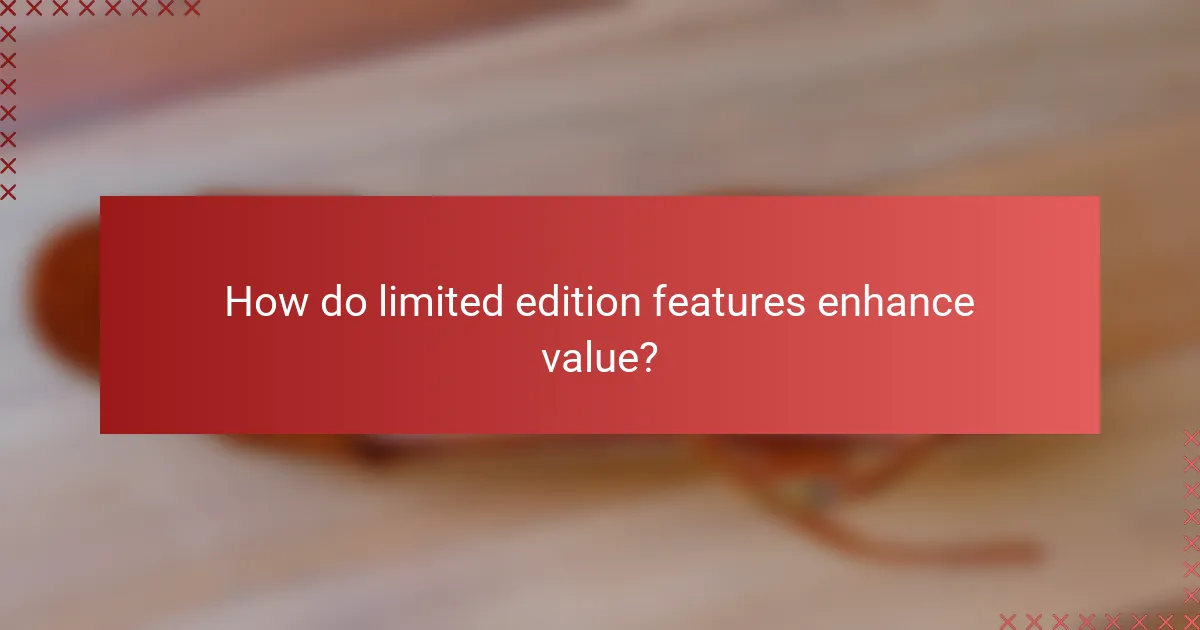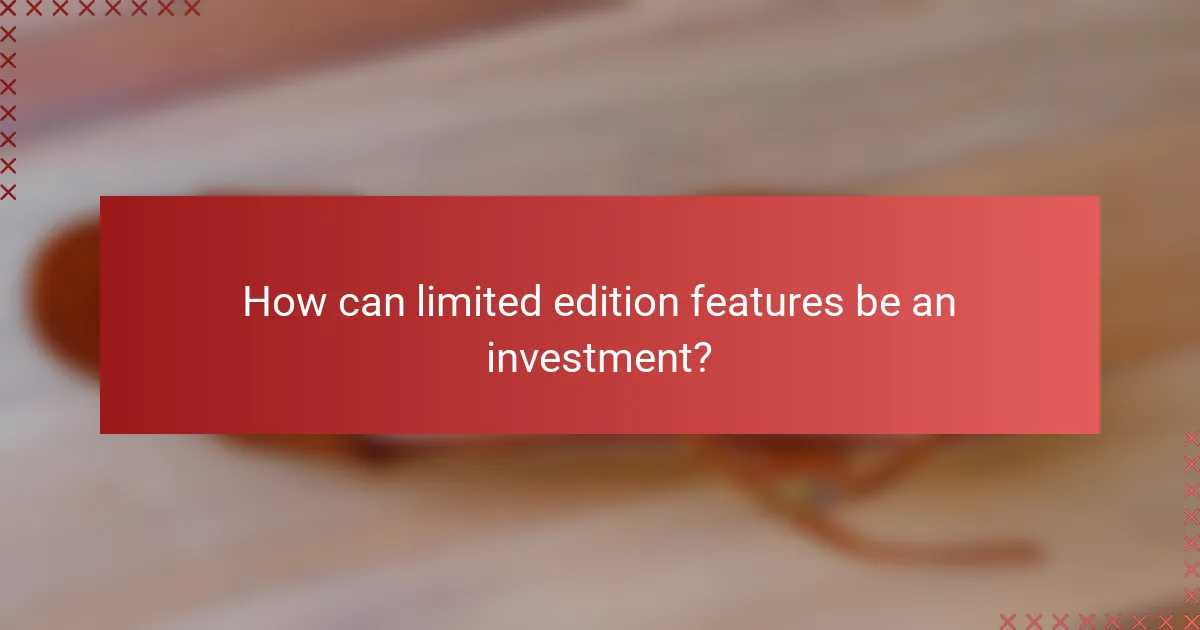Limited edition features significantly enhance the value of products by offering exclusivity and unique designs that appeal to both consumers and collectors. With their restricted availability and potential for appreciation, these items not only attract attention but also serve as viable investments, often leading to increased demand and higher resale prices over time.

How do limited edition features enhance value?
Limited edition features enhance value by offering exclusivity, unique designs, and potential for appreciation over time. These elements create a compelling proposition for consumers and collectors alike, making such items more desirable and often more expensive.
Increased resale potential
Limited edition items typically have higher resale potential compared to standard versions. This is due to their scarcity; as fewer units are available, demand often drives up prices in secondary markets. Collectors may pay a premium, sometimes exceeding the original retail price by significant margins.
For example, a limited edition watch might retail for $5,000 but could resell for $8,000 to $12,000, depending on its rarity and condition. It’s crucial to research market trends and historical resale values to gauge potential investment returns.
Unique design elements
Limited edition features often include unique design elements that set them apart from regular products. These can be special colors, materials, or custom engravings that enhance the item’s aesthetic appeal. Such distinctiveness not only attracts buyers but also contributes to the perceived value.
For instance, a limited edition sneaker might feature a unique colorway or exclusive branding that makes it more attractive to enthusiasts. This uniqueness can create a sense of ownership and pride among collectors.
Brand prestige
Brands that release limited edition items often enhance their prestige and reputation in the market. By associating with exclusivity, these brands can elevate their status among consumers, making their products more desirable. This perception can lead to increased loyalty and a stronger brand identity.
Luxury brands like Rolex or Louis Vuitton exemplify this; their limited edition releases often sell out quickly, reinforcing their high-end image and desirability. Consumers are willing to pay more for items that signify status and exclusivity.
Collector demand
Collector demand plays a significant role in the value of limited edition features. Enthusiasts often seek out these items to complete their collections, driving up demand and prices. The more sought-after an item is, the more likely it is to appreciate in value over time.
For example, limited edition comic books or art prints can see substantial increases in value as collectors vie for ownership. Understanding the collector community and trends can help buyers make informed decisions about their investments in limited edition features.

What makes limited edition products exclusive?
Limited edition products are exclusive due to their restricted availability, unique features, and often special collaborations. This exclusivity enhances their appeal and can significantly increase their value over time.
Scarcity and availability
Scarcity is a key factor in the exclusivity of limited edition products. When items are produced in small quantities, they become more desirable to collectors and enthusiasts. For instance, a brand might release only a few hundred units of a particular sneaker, driving demand and elevating its market value.
Availability can vary widely based on the product type and market. Some limited editions might be available only in select regions or through specific retailers, further enhancing their allure. It’s crucial for buyers to act quickly, as these items often sell out within hours or days.
Special collaborations
Collaborations between brands or artists often result in limited edition products that stand out in the market. These partnerships can bring together unique design elements or cultural significance, making the items more appealing. For example, a fashion label might collaborate with a renowned artist to create a limited run of clothing, merging art and fashion.
Such collaborations not only enhance the product’s uniqueness but also create a narrative that can resonate with consumers. This storytelling aspect can significantly boost the perceived value of the item, making it a sought-after collectible.
Unique packaging
Unique packaging is another element that contributes to the exclusivity of limited edition products. Often, these items come in specially designed boxes or containers that reflect their unique status. For instance, a limited edition whiskey might be packaged in a handcrafted wooden box, adding to its overall appeal.
Investing in distinctive packaging can enhance the unboxing experience and create a sense of luxury. Collectors often appreciate these details, as they can increase the product’s value over time. When purchasing limited editions, consider the packaging as part of the overall investment.

How can limited edition features be an investment?
Limited edition features can serve as a viable investment by offering potential for value appreciation and exclusivity. Collectors and investors often seek these unique items, anticipating that their rarity will lead to increased demand and higher resale prices over time.
Historical price appreciation
Historically, limited edition items have shown significant price appreciation, particularly in categories like art, collectibles, and luxury goods. For example, certain limited edition sneakers or watches can appreciate by tens to hundreds of percent over a few years, depending on demand and condition.
Investors should research past performance trends for specific items or brands to gauge potential future value. Notable auction results can provide insights into how much similar items have sold for, helping to set realistic expectations.
Market trends analysis
Analyzing market trends is crucial for understanding the investment potential of limited edition features. Factors such as consumer interest, cultural relevance, and economic conditions can influence demand and pricing. Keeping an eye on social media buzz and collector forums can provide valuable insights into which items are gaining popularity.
Additionally, tracking sales data from reputable auction houses or online marketplaces can help identify emerging trends. Investors should consider diversifying their collections based on these insights to mitigate risks and enhance potential returns.
Investment-grade collectibles
Investment-grade collectibles are items that meet specific criteria for quality, rarity, and demand, making them suitable for investment purposes. These can include limited edition art prints, vintage toys, or rare coins that have a proven track record of value retention or appreciation.
When investing in collectibles, focus on items with strong provenance and condition. Certifications from recognized grading services can enhance an item’s value and marketability. Always consider the costs associated with buying, storing, and selling these items, as they can impact overall returns.

What criteria should you consider when purchasing limited editions?
When purchasing limited editions, consider factors such as brand reputation, market demand, and the condition and authenticity of the item. These criteria can significantly influence the value and potential investment return of your purchase.
Brand reputation
The brand’s reputation plays a crucial role in the desirability of limited edition items. Well-established brands with a history of quality and exclusivity tend to retain or increase their value over time. Research the brand’s past limited releases to gauge their performance in the market.
Look for brands that have a loyal following and a track record of successful limited editions. For example, luxury brands like Rolex or Louis Vuitton often see their limited pieces appreciate significantly due to their strong brand equity.
Market demand
Understanding market demand is essential when considering a limited edition purchase. High demand can drive up prices, while low demand may lead to depreciation. Monitor trends in the market and assess how similar items have performed over time.
Utilize platforms like auction sites or collector forums to gauge interest levels. Items that are highly sought after, such as rare sneakers or collectible art, often see prices soar, making them more valuable investments.
Condition and authenticity
The condition and authenticity of a limited edition item are critical for its value. Items in pristine condition with original packaging and documentation are generally more desirable. Always verify authenticity through reputable sources or certification services.
Be cautious of replicas or counterfeit items, as they can significantly diminish value. When purchasing, request detailed photographs and, if possible, provenance information to ensure you are acquiring a genuine piece.

How do shipping and returns work for limited edition items?
Shipping and returns for limited edition items often come with specific policies that reflect their exclusivity. Generally, these items may have unique shipping options and stricter return guidelines compared to regular products.
Shipping policies for exclusives
Shipping policies for limited edition items typically prioritize speed and security. Many retailers offer expedited shipping options to ensure that collectors receive their items quickly, often within a few days. It’s common for shipping fees to be higher for these exclusive products due to their value and rarity.
Some companies may provide tracking services for limited edition shipments, allowing customers to monitor their package’s journey. Additionally, consider insurance for high-value items, as this can protect your investment during transit.
Return policies for limited editions
Return policies for limited edition items are often more restrictive than standard returns. Many retailers may not accept returns on these products unless they are defective or damaged upon arrival. This is due to their limited nature and the potential impact on resale value.
Before purchasing, check the specific return policy details, including any time limits for returns and conditions for item acceptance. It’s advisable to keep all original packaging and receipts, as these may be required for any potential returns or exchanges.

What are the risks associated with investing in limited editions?
Investing in limited editions carries several risks that potential buyers should consider. These include market volatility, the potential for counterfeit items, and the challenge of liquidity when trying to sell these exclusive pieces.
Market Volatility
The value of limited edition items can fluctuate significantly based on market demand and trends. Factors such as changing consumer preferences, economic conditions, and the popularity of the brand can all impact prices. For instance, a limited edition sneaker may be highly sought after initially but could lose value if a newer model is released.
Investors should monitor market trends closely and be prepared for the possibility that their investment may not appreciate as expected. It’s wise to diversify investments to mitigate the risks associated with any single limited edition item.
Counterfeit Risks
Counterfeiting is a significant concern in the limited edition market, particularly for high-value items like art and collectibles. Buyers must ensure they are purchasing from reputable sources to avoid counterfeit products that can drastically reduce the value of their investment.
To protect against counterfeits, consider obtaining items with verified authenticity, such as those accompanied by certificates or from trusted dealers. Researching the seller’s reputation and understanding the item’s provenance can also help mitigate this risk.
Liquidity Challenges
Limited edition items can pose liquidity challenges, meaning they may not sell quickly or at the desired price. Unlike stocks or bonds, which can be traded easily, selling a limited edition piece often requires finding the right buyer who values the item similarly.
To enhance liquidity, consider investing in items that have a broader appeal or are part of a well-established brand. Additionally, being patient and timing the market can help in achieving a better return when selling.
